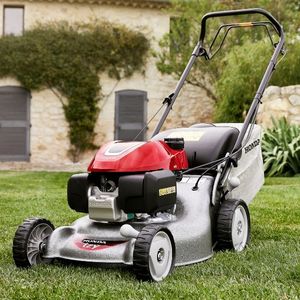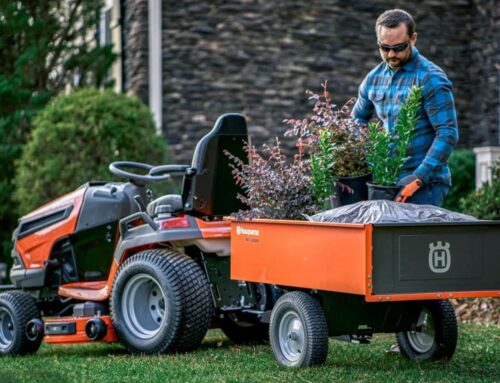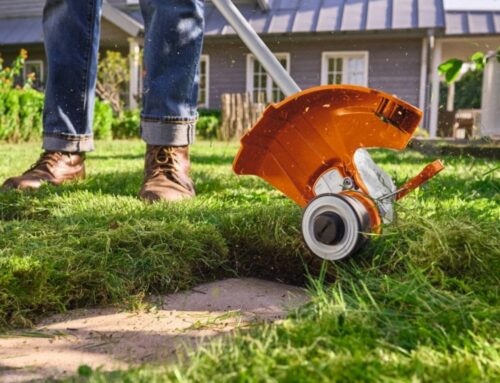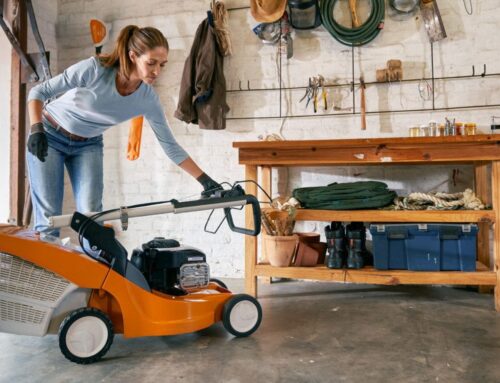
Essential Autumn Lawn Care Tips to Prepare Your Grass for Winter
With autumn deepening, the cooler temperatures and shorter days make now the time to protect your grass, strengthen its roots, and set the stage for its lush green revival next spring. To help you achieve this, we’re going to talk you through the essential autumn grass care jobs—from mowing and leaf removal to aeration, fertilisation, and moss prevention. We’ll also explain why watering is rarely needed at this time of year and why autumn lawn scarifying should now wait until spring. So, if you want to keep your lawn resilient through the colder months, why not pour yourself a cuppa and take a few minutes to read our grass care autumn guide…
Mowing: How to Approach the Last Cuts of the Season
 By late October, grass growth is easing off, but you’ll still see the odd spurt in milder spells. The goal with cutting grass in autumn is to keep the lawn tidy without weakening it. For most British lawns with cool-season grasses, set your lawnmower cutting height to around 1.4–1.8 inches (3.5–4.5 cm) at this point in time; it’s tall enough to protect the crown from chill and persistent moisture, yet short enough to keep a neat finish. If your lawn is under shade, experiences heavy footfall, or is still recovering from summer stress, lean towards the top end of the range.
By late October, grass growth is easing off, but you’ll still see the odd spurt in milder spells. The goal with cutting grass in autumn is to keep the lawn tidy without weakening it. For most British lawns with cool-season grasses, set your lawnmower cutting height to around 1.4–1.8 inches (3.5–4.5 cm) at this point in time; it’s tall enough to protect the crown from chill and persistent moisture, yet short enough to keep a neat finish. If your lawn is under shade, experiences heavy footfall, or is still recovering from summer stress, lean towards the top end of the range.
Ride-on and robot mowers benefit from a slightly higher setting—typically 1.6–2.0 inches (4.0–5.0 cm). If you own a rider, lifting the deck a touch improves airflow, reduces clogging when dew lingers, and helps you collect light leaf fall more cleanly.
Last Grass Cut of the Year UK
 There’s no set date for the last lawn cut of the year UK-wide because it depends on where you live and the prevailing weather conditions. For example, timings will differ in the North of Scotland compared to the South Coast, and vary according to the autumn temperatures from year to year. Best practice is to aim for a final tidy pass on a dry day when growth has genuinely paused, wherever you happen to live. Some years that might be early November; other years a brief mild spell may justify a light topping later. So, watch the weather, mow dry, and avoid removing more than a third of the lawn’s height in any single pass.
There’s no set date for the last lawn cut of the year UK-wide because it depends on where you live and the prevailing weather conditions. For example, timings will differ in the North of Scotland compared to the South Coast, and vary according to the autumn temperatures from year to year. Best practice is to aim for a final tidy pass on a dry day when growth has genuinely paused, wherever you happen to live. Some years that might be early November; other years a brief mild spell may justify a light topping later. So, watch the weather, mow dry, and avoid removing more than a third of the lawn’s height in any single pass.
In short, cutting grass autumn-time demands a calm, conservative approach that leaves a slightly taller, more resilient sward. It’s all about making small, thoughtful adjustments to protect the plant, not a dramatic change that might cause problems later.
Leaf Removal: Keep On Top of It
 Leaf fall can smother grass surprisingly quickly. A thin, wet layer blocks light and traps moisture against the sward, encouraging moss and inviting disease. The fix is simple. Make leaf clearance a gentle, regular habit—little and often—so the lawn keeps breathing. If leaves are dry, a rotary mower on a higher setting can vacuum and shred them, helping with collection and turning waste into a useful mulch elsewhere in the garden. Where leaves are heavy or wet, use a rake or blower first, then tidy the surface with your mower.
Leaf fall can smother grass surprisingly quickly. A thin, wet layer blocks light and traps moisture against the sward, encouraging moss and inviting disease. The fix is simple. Make leaf clearance a gentle, regular habit—little and often—so the lawn keeps breathing. If leaves are dry, a rotary mower on a higher setting can vacuum and shred them, helping with collection and turning waste into a useful mulch elsewhere in the garden. Where leaves are heavy or wet, use a rake or blower first, then tidy the surface with your mower.
Consistent leaf management is a pillar of good autumn lawn maintenance because it preserves light and airflow at exactly the time your grass needs both. It also keeps moss and slippery patches in check, preventing the muddy, patchy look that’s hard to recover from in spring.
Aeration: Relieve Compaction and Channel Water Where It’s Needed
 Soil compaction builds through summer footfall and dry spells. Autumn is the smart moment to relieve it because the ground has moisture, roots are active, and rainfall is frequent. Use a garden fork or aerator to open pathways for air, water and nutrients. On heavy or high-traffic lawns, you’ll see a double benefit: better drainage during wet spells and deeper rooting that steadies the sward through winter.
Soil compaction builds through summer footfall and dry spells. Autumn is the smart moment to relieve it because the ground has moisture, roots are active, and rainfall is frequent. Use a garden fork or aerator to open pathways for air, water and nutrients. On heavy or high-traffic lawns, you’ll see a double benefit: better drainage during wet spells and deeper rooting that steadies the sward through winter.
If frost is forecast, hold off on aggressive methods; instead, stick to lighter aeration that makes small holes without lifting cores. Follow aeration with a feed because the lawn will take up nutrients more efficiently through freshly opened channels. A key part of your grass care autumn routine, aeration is a quiet win that improves everything else you do, from feeding to moss control.
Feeding: Potassium-Led Nutrition for Stronger Winter Resilience
 An autumn feed isn’t about pushing soft, sappy growth; it’s about resilience. Choose a low-nitrogen, higher-potassium formulation to toughen cell walls, support root energy reserves, and maintain colour without surge growth. If it’s in liquid form, you might find it helpful to use a sprayer. In many parts of England, late October is still a reasonable window for an autumn-specific product if soils are mild; further north or in cooler microclimates, pivot to a winter-appropriate, high-iron option that greens the lawn while discouraging moss.
An autumn feed isn’t about pushing soft, sappy growth; it’s about resilience. Choose a low-nitrogen, higher-potassium formulation to toughen cell walls, support root energy reserves, and maintain colour without surge growth. If it’s in liquid form, you might find it helpful to use a sprayer. In many parts of England, late October is still a reasonable window for an autumn-specific product if soils are mild; further north or in cooler microclimates, pivot to a winter-appropriate, high-iron option that greens the lawn while discouraging moss.
For the best autumn lawn care, a well-timed feed after aeration is particularly effective—you’ll notice steadier colour through early winter, fewer thin patches, and an easier start in spring.
Moss Prevention: Cultural Habits and Targeted Treatments
 Moss loves three things in autumn and winter: shade, persistent moisture, and weak grass. Preventing these conditions arising is an important autumn lawn prep task. Your first line of defence is cultural: keep the lawn a little taller, maintain airflow with regular leaf clearance, and avoid scalping into the sward when cutting grass in autumn. Where moss appears, consider a liquid iron treatment to harden the lawn and suppress the moss, without forcing growth. Apply on a suitable day weather-wise and, importantly, don’t try to rake all of the moss out now. Heavy raking in late autumn can leave the lawn thin with too little recovery time before winter.
Moss loves three things in autumn and winter: shade, persistent moisture, and weak grass. Preventing these conditions arising is an important autumn lawn prep task. Your first line of defence is cultural: keep the lawn a little taller, maintain airflow with regular leaf clearance, and avoid scalping into the sward when cutting grass in autumn. Where moss appears, consider a liquid iron treatment to harden the lawn and suppress the moss, without forcing growth. Apply on a suitable day weather-wise and, importantly, don’t try to rake all of the moss out now. Heavy raking in late autumn can leave the lawn thin with too little recovery time before winter.
Think of moss management now as containment, not renovation. By keeping moss in check through winter, you’ll start spring with a smaller problem and a thicker, happier lawn.
Watering: Currently Unlikely to Be Needed
At this stage of the season, natural rainfall and long dews usually provide ample moisture. Unless you’ve recently overseeded, or we suddenly experience a prolonged dry spell, watering simply isn’t required. In fact, keeping surfaces too wet for too long risks disease and encourages moss. So, for sensible lawn care in the autumn, a good rule of thumb is to let the weather do the heavy lifting.
Why Scarifying Waits Until Next Year
A strong scarify removes thatch and moss, but it also exposes soil and thins the sward temporarily. By late October, there isn’t enough consistent warmth or daylight to guarantee quick recovery. You’d risk bare patches that stay open over winter, inviting more weeds and moss. So, if you’ve yet to scarify your lawn, sit tight and file this task under ‘renovation for spring’, making a note to pair it with overseeding and an appropriate feed when the weather favours regrowth. Deferring now protects the lawn’s current structure and avoids winter-long patchiness.
 Good Autumn Lawn Care Means a Better Spring
Good Autumn Lawn Care Means a Better Spring
The essence of autumn lawn care is calm, consistent work that supports grass as growth slows. As shown above, this entails measured mowing at a slightly higher setting, reliable leaf clearance, well-timed aeration, and a potassium-led feed that strengthens rather than stimulates. Add in sensible moss prevention, and you’ve built a plan that protects your lawn through the winter months.
And finally, don’t waste your time searching for a set date in ‘last grass cut of year UK’ articles—simply do what your lawn is telling you. If it’s still growing, give it a light, high cut on a dry day. If it’s stopped, give your mower a good clean and put it in the shed until spring.
Ron Smith & Co: The Home of Great Lawncare
 At Ron Smith & Co, we’re proud to be one of the nation’s leading suppliers of garden tools and machinery. From lawnmowers and leaf blowers to scarifiers, aerators, and sprayers, we stock everything needed to create a healthy, attractive lawn. And if you have any questions about the equipment that we sell, or would like further autumn lawn maintenance advice, our friendly team is always on-hand to help.
At Ron Smith & Co, we’re proud to be one of the nation’s leading suppliers of garden tools and machinery. From lawnmowers and leaf blowers to scarifiers, aerators, and sprayers, we stock everything needed to create a healthy, attractive lawn. And if you have any questions about the equipment that we sell, or would like further autumn lawn maintenance advice, our friendly team is always on-hand to help.




